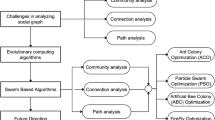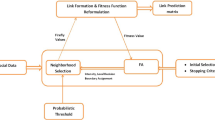Abstract
The problem of link prediction has recently gained a lot of attention from various domains, including sociology, anthropology, information science, and computer science. In this research, we formulated the link prediction problem as an optimization problem to predict the links of any type of network and proposed two artificial bee colony-based link prediction algorithms enhanced with some neighborhood structures borrowed from genetic algorithms. In an attempt to complete the network’s missing links, the first algorithm optimizes weights, which are used in a linear combination with local and global similarity indexes, to capture the best of both schemes and compensate for each approach’s weaknesses. In the second one, we make use of the community structure of the network to help predict the missing links present in the networks. Experimental results of the proposed algorithms on a number of real-world and synthetic networks provided interesting insights about the problem and showed that the proposed algorithms can enhance link prediction accuracy and are quite competitive with state-of-the-art algorithms.









Similar content being viewed by others
Data Availability
The datasets analyzed during the current study are available in the Konect repository, http://konect.cc/networks/. And also in the Network Repository, https://networkrepository.com/index.php
References
Adamic LA, Adar E (2003) Friends and neighbors on the web. Soc Networks 25:211–230. https://doi.org/10.1016/S0378-8733(03)00009-1
Aziz F, Gul H, Muhammad I, Uddin I (2020) Link prediction using node information on local paths. Physica A Stat Mech Appl 557:124980. https://doi.org/10.1016/j.physa.2020.124980
Barabási A-L, Albert R (1999) Emergence of scaling in random networks. Science 286:509–512. https://doi.org/10.1016/S0378-4371(00)00018-2
Barham R, Aljarah I, (2017) Link prediction based on whale optimization algorithm. In, (2017) International conference on new trends in computing sciences (ICTCS), pp 55–60. IEEE. https://doi.org/10.1109/ICTCS.2017.41
Barham R, Sharieh A, Sleit A (2018) Moth flame optimization based on golden section search and its application for link prediction problem. Mod Appl Sci 13:10–27. https://doi.org/10.5539/mas.v13n1p10
Barham RS, Sharieh A, Sleit A (2019) A meta-heuristic framework based on clustering and preprocessed datasets for solving the link prediction problem. J Inf Sci 45:794–817. https://doi.org/10.1177/0165551518816296
Biswas A, Biswas B (2017) Community-based link prediction. Multimedia Tools Appl 76:18619–18639. https://doi.org/10.1007/s11042-016-4270-9
Bliss CA, Frank MR, Danforth CM, Dodds PS (2014) An evolutionary algorithm approach to link prediction in dynamic social networks. J Comput Sci 5:750–764. https://doi.org/10.1016/j.jocs.2014.01.003
Blondel VD, Guillaume J-L, Lambiotte R, Lefebvre E (2008) Fast unfolding of communities in large networks. J Stat Mech Theory Exp 2008:P10008. https://doi.org/10.1088/1742-5468/2008/10/P10008
Brandes U (2001) A faster algorithm for betweenness centrality. J Math Sociol 25:163–177. https://doi.org/10.1080/0022250X.2001.9990249
Chen B, Chen L (2014) A link prediction algorithm based on ant colony optimization. Applied Intelligence 41. https://doi.org/10.1007/s10489-014-0558-5
Daud NN, Ab Hamid SH, Saadoon M, Sahran F, Anuar NB (2020) Applications of link prediction in social networks:A review. J Netw Comput Appl, pp 102716. https://doi.org/10.1016/j.jnca.2020.102716
Del Ser J, Osaba E, Molina D, Yang X-S, Salcedo-Sanz S, Camacho D, Das S, Suganthan PN, Coello CAC, Herrera F (2019) Bio-inspired computation: Where we stand and what’s next. Swarm Evol Comput 48:220–250. https://doi.org/10.1016/j.swevo.2019.04.008
Ding J, Jiao L, Wu J, Liu F (2016) Prediction of missing links based on community relevance and ruler inference. Knowl-Based Syst 98:200–215. https://doi.org/10.1016/j.knosys.2016.01.034
Fortunato S (2010) Community detection in graphs. Phys Rep 486:75–174. https://doi.org/10.1016/j.physrep.2009.11.002
Golbeck J (2015) Chapter 21 - analyzing networks. In: Golbeck J (Ed.) Introduction to social media investigation, pp 221–235 Boston: Syngress. https://doi.org/10.1016/B978-0-12-801656-5.00021-4
Karaboga D, Gorkemli B, Ozturk C, Karaboga N (2014) A comprehensive survey:artificial bee colony (abc) algorithm and applications. Artif Intell Rev 42:21–57. https://doi.org/10.1007/s10462-012-9328-0
Karaboga D et al (2005) An idea based on honey bee swarm for numerical optimization. Technical Report Technical report-tr06, Erciyes university, engineering faculty, computer engineering department
Katz L (1953) A new status index derived from sociometric analysis. Psychometrika 18:39–43. https://doi.org/10.1007/BF02289026
Kumar A, Singh SS, Singh K, Biswas B (2020) Link prediction techniques, applications, and performance: A survey. Physica A Stat Mech Appl 553:124289. https://doi.org/10.1016/j.physa.2020.124289
Kumari A, Behera RK, Sahoo B, Sahoo SP (2022) Prediction of link evolution using community detection in social network. Computing, pp 1–22. https://doi.org/10.1007/s00607-021-01035-4
Kunegis J (2013a) Konect: The koblenz network collection. In: Proceedings of the 22nd international conference on world wide web WWW ’13 Companion, pp 1343–1350. New York, NY, USA Association for computing machinery. https://doi.org/10.1145/2487788.2488173
Kunegis J (2013b) Konect:the koblenz network collection. In: Proceedings of the 22nd international conference on world wide web, pp 1343–1350. https://doi.org/10.1145/2487788.2488173
Lancichinetti A, Fortunato S, Radicchi F (2008) Benchmark graphs for testing community detection algorithms. Physical review E 78:046110. https://doi.org/10.1103/PhysRevE.78.046110
Lei C, Ruan J (2013) A novel link prediction algorithm for reconstructing protein-protein interaction networks by topological similarity. Bioinformatics 29:355–364. https://doi.org/10.1093/bioinformatics/bts688
Li L, Cheng Y, Tan L, Niu B (2011) A discrete artificial bee colony algorithm for tsp problem. In: International conference on intelligent computing, pp 566–573. Springer. https://doi.org/10.1007/978-3-642-24553-4_75
Li Z, Fang X, Sheng ORL (2017) A survey of link recommendation for social networks: Methods, theoretical foundations, and future research directions. ACM Trans Manag Inf Syst 9:1–26. https://doi.org/10.1145/3131782
Liben-Nowell D, Kleinberg J (2003) The link prediction problem for social networks. In: Proceedings of the twelfth international conference on information and knowledge management, pp 556–559. https://doi.org/10.1145/956863.956972
Liben-Nowell D, Kleinberg J (2007) The link-prediction problem for social networks. J Assoc Inf Sci Technol 58:1019–1031. https://doi.org/10.1002/asi.20591
Lü L, Zhou T (2011) Link prediction in complex networks: A survey. Physica A Stat Mech Appl 390:1150–1170. https://doi.org/10.1016/j.physa.2010.11.027
Luo J-D (2005) Particularistic trust and general trust: A network analysis in chinese organizations. Manag Organ Rev 1:437–458. https://doi.org/10.1111/j.1740-8784.2005.00022.x
Martínez V, Galiano FB, Cubero JC (2016) A survey of link prediction in complex networks. ACM Comput Surv 49:69:1–69:33. https://doi.org/10.1145/3012704
Mastrandrea R, Fournet J, Barrat A (2015) Contact patterns in a high school:a comparison between data collected using wearable sensors, contact diaries and friendship surveys. PloS one 10:e0136497. https://doi.org/10.1371/journal.pone.0136497
Newman MEJ (2006) Finding community structure in networks using the eigenvectors of matrices. Phys Rev E 74:036104. https://doi.org/10.1103/PhysRevE.74.036104
Opsahl T, Panzarasa P (2009) Clustering in weighted networks. Soc Networks 31:155–163. https://doi.org/10.1016/j.socnet.2009.02.002
Osaba E, Villar-Rodriguez E, Del Ser J, Nebro AJ, Molina D, LaTorre A, Suganthan PN, Coello CAC, Herrera F (2021) A tutorial on the design, experimentation and application of metaheuristic algorithms to real-world optimization problems. Swarm Evol Comput 64:100888. https://doi.org/10.1016/j.swevo.2021.100888
Özcan A, Öğüdücü ŞG (2016) Temporal link prediction using time series of quasi-local node similarity measures. In, (2016) 15th IEEE international conference on machine learning and applications (ICMLA), pp 381–386. IEEE. https://doi.org/10.1109/ICMLA.2016.0068
Pulipati S, Somula R, Parvathala BR (2021) Nature inspired link prediction and community detection algorithms for social networks:a survey. Int J Syst Assur Eng Manag, pp 1–18. https://doi.org/10.1007/s13198-021-01125-8
Raut P, Khandelwal H, Vyas G (2020) A comparative study of classification algorithms for link prediction. In: (2020) 2nd International conference on innovative mechanisms for industry applications (ICIMIA), pp 479–483. IEEE. https://doi.org/10.1109/ICIMIA48430.2020.9074840
Rossi R, Ahmed N (2015) The network data repository with interactive graph analytics and visualization. In: Proceedings of the AAAI conference on artificial intelligence, vol 29. https://doi.org/10.1609/aaai.v29i1.9277
Safdari H, Contisciani M, De Bacco C (2022) Reciprocity, community detection, and link prediction in dynamic networks. J Phys Complex 3:015010. https://doi.org/10.1088/2632-072X/ac52e6
Salha-Galvan G, Lutzeyer JF, Dasoulas G, Hennequin R, Vazirgiannis M (2022) Modularity-aware graph autoencoders for joint community detection and link prediction. Neural Netw 153:474–495. https://doi.org/10.1016/j.neunet.2022.06.021
Shang K-k, Small M (2022) Link prediction for long-circle-like networks. Physical review E 105:024311. https://doi.org/10.1103/PhysRevE.105.024311
Singh SS, Mishra S, Kumar A, Biswas B (2020) Clp-id:Community-based link prediction using information diffusion. Inf Sci 514:402–433. https://doi.org/10.1016/j.ins.2019.11.026
Soundarajan S, Hopcroft J (2012) Using community information to improve the precision of link prediction methods. In: Proceedings of the 21st international conference on World Wide Web, pp 607–608. https://doi.org/10.1145/2187980.2188150
Srilatha P, Manjula R (2017) Structural similarity based link prediction in social networks using firefly algorithm. In: (2017) International conference on smart technologies for smart nation (SmartTechCon), pp 560–564. IEEE. https://doi.org/10.1109/SmartTechCon.2017.8358434
Wang P, Xu B, Wu Y, Zhou X (2014) Link prediction in social networks:the state-of-the-art. Sci China Inf Sci 58:1–38. https://doi.org/10.48550/ar**v.1411.5118
Yan B, Gregory S (2012) Finding missing edges in networks based on their community structure. Phys Rev E 85:056112. https://doi.org/10.1103/PhysRevE.85.056112
Zachary WW (1977) An information flow model for conflict and fission in small groups. J Anthropol Res 33:452–473. https://doi.org/10.1086/jar.33.4.3629752
Zeng S (2016) Link prediction based on local information considering preferential attachment. Physica A Stat Mech Appl 443:537–542. https://doi.org/10.1016/j.physa.2015.10.016
Author information
Authors and Affiliations
Corresponding author
Ethics declarations
Conflicts of interest
The authors declare that they have no conflict of interest.
Additional information
Publisher's Note
Springer Nature remains neutral with regard to jurisdictional claims in published maps and institutional affiliations.
Rights and permissions
Springer Nature or its licensor (e.g. a society or other partner) holds exclusive rights to this article under a publishing agreement with the author(s) or other rightsholder(s); author self-archiving of the accepted manuscript version of this article is solely governed by the terms of such publishing agreement and applicable law.
About this article
Cite this article
Kerkache, H.M., Sadeg-Belkacem, L. & Tayeb, F.BS. Improved artificial bee colony algorithm based on community detection for link prediction problem. Multimed Tools Appl 83, 41655–41681 (2024). https://doi.org/10.1007/s11042-023-17197-6
Received:
Revised:
Accepted:
Published:
Issue Date:
DOI: https://doi.org/10.1007/s11042-023-17197-6




